Beaded Chainmaille Jewelry Tutorial — Video 1
Beaded chainmaille jewelry tutorials are less common than standard chainmaille jewelry patterns, and I thought it was time that I did a video showing some patterns with beads. This is a project video, where we’ll make a bracelet. I also will show some other design options.
Oh, and why do I say “Video 1”? Naturally, I plan for more beaded chainmaille jewelry patterns!
Why Beaded Chainmaille?
Now I have a lot of different chainmaille bracelets — right now I’m wearing a roundmaille, a Turkish roundmaille and a Jens Pind. But up to this point I hadn’t done anything with beads, except as a dangle off an earring. Beaded chainmaille is a change of pace — and I am looking forward to making a bracelet incorporating sterling and pearls.
Supplies You’ll Need
All of the ring gauges list below are AWG. When I say 18 gauge, I mean a 1mm wire diameter.
- 18 gauge 6mm inside diameter rings (AR = 6)
- 6mm bicone beads — I am using Swarovski, in the color Scarlet.
- 18 gauge 3.5mm or 4mm inside diameter (AR = 3.5 or 4)
- Clasp of your choice
You will need approximately 3 beads and 12 of the 6mm ID jump rings per inch of finished chain. As for the small jump rings, you will only need two or so, depending on what kind of clasp you plan to use. (In my case, I elected to make an “S” clasp that used one of the Swarovski bicones.)
If you want to make the green and gold bracelet, you’ll need more of the smaller jump rings and fewer of the large jump rings and bicone beads. And if you want to add a dangle or charm, you’ll need to include those.
Beaded Chainmaille Video Tutorial
Ready…set…let’s get maille-ing with this beaded chainmaille bracelet!
Chain Maille Tutorial – HP 3in1, HP 4in1, DragonBack
The chain maille HP (Half Persian) weaves are intriguing and DragonBack is exciting! Well, at least that’s my opinion. How a person can take the small rings and make such a densely-woven piece of jewelry was amazing to me. Welcome to the HP world!
I know that HP has the reputation of being difficult, but it really isn’t — at least not without a little help in the very beginning (which of course I provide). Then like most weaves, once you have the rhythm, it’s not all that hard at all! There are lots of very detailed photos to show you what ring goes where.
(Note to anyone reading this post on Google Translate — this ebook is written in English.)
What’s in the Tutorial?
We’ll start out with the easiest of the weaves — the HP3in1. With a couple of tips in the very beginning on how to start the weave, it becomes a whole lot easier!
Once you have the hang of that weave, time to move onto the HP 4in1. This is a beautiful, very dense weave. Once again I provide two different ways to start out the weave to make things that much easier!
Do you want to double your fun? How about a doubled HP 4in1! It’s actually pretty easy, and it’s reversible in a way that can give you two different looks.
We’ll finish up with DragonBack, which is a weave that is rather unusual and not often seen. It, too, is a dense weave, and it makes a very substantial piece of jewelry. Not to mention an absolutely gorgeous one! But please note — DragonBack and the more commonly-seen DragonScale are not the same weave. In this ebook I teach you DragonBack.
With these weaves, I demonstrate each weave in at least two different color rings, so you can more easily see how the weave is put together. I also show some common mistakes, how to recognize them quickly and how to fix them.
There’s lots in the ebook. It’s 37 pages and has 79 photos, so you have a lot of instructions and plenty of close-ups. The photo at the top of the page shows all the weaves you’ll find in this ebook tutorial. This ebook is in PDF form, and is just a little over 1.6 MB in size.
Purchase the Tutorial
The ebook is just $6, which is a small amount for everything you get, especially with the super-close-up photos — which many times I show multiple angles so you are sure where to put that next ring!
You can buy the ebook securely through the link below. All major credit cards are accepted. Just as an FYI, it does go through the PayPal interface. You will get a link for an immediate download — and then you’re on your way!
Thanks so much for reading this far, and happy maille-ing!
Jump Rings for Maille – Part 1
Now it’s time to talk about jump rings – materials, sizes and that dreaded term…aspect ratio. ‘Cause face it — without jump rings, there is no chain maille.
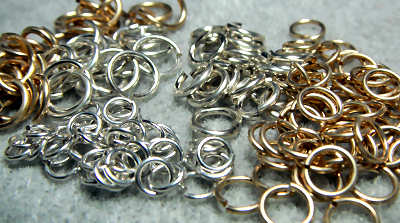 When I started with making chain maille there wasn’t a huge variety of jump rings for use with jewelry. Most of the ring suppliers catered to the non-jewelry market. The jewelry supply stores sold rings based on outside diameter (OD), so you had to figure out the inside diameter (ID) yourself. Not to mention there wasn’t a huge variety of gauges, sizes or materials.
When I started with making chain maille there wasn’t a huge variety of jump rings for use with jewelry. Most of the ring suppliers catered to the non-jewelry market. The jewelry supply stores sold rings based on outside diameter (OD), so you had to figure out the inside diameter (ID) yourself. Not to mention there wasn’t a huge variety of gauges, sizes or materials.
Now things are all changed — we jewelry artists have access to all kinds of wonderful rings in loads of materials and sizes. Woo hoo!
Chain Maille – Art, Science or Both?
No doubt about it, maille is an art; all one has to do is look at the myriad items, jewelry or not. But there is also a scientific aspect to making maille, because for many patterns, you need rings of a specific size. That size varies according to the gauge of the wire. Yikes — head spinning yet?
This relationship between gauge and size is called the aspect ration (AR). It’s a term guaranteed to make your eyes glaze over, LOL. However, it’s something you do need to know about if you want to maille.
You don’t have to know the math, but you do need to know the AR (or know how to find it) for any given ring. For example, the pattern Jens Pind requires a very specific AR in order to work; it’s a very narrow range. Something like European 4-in-1 is a lot more forgiving, but it still needs a certain range of sizes in order to look its best.
I wrote up an ebook (free) about AR, and it has a nifty chart in it that lists the ARs for some of the most common jewelry maille ring sizes and gauges. So here you go – chain maille rings.
So yes, there is science involved — but when has science been this much fun?
Ring Materials — My Precious….
When I was starting to maille (back in the stone ages I think), sterling silver was pretty cheap, so I mostly used sterling. Plus, it was one of the few metals that I could get rings for in a variety of ARs and gauges.
These days sterling is not exactly cheap, but there are all kinds of other materials now so I am not too disappointed. While I still love silver, my heart has been wooed by colorful rings in aluminum, copper, niobium and titanium. That being said, let’s talk materials. I’ll start with the metals classes as “precious” in chain maille terms – gold, silver, niobium and titanium.
Gold
Gold is gorgeous, no doubt about it. It’s available in yellow,white and rose; as solid and gold-filled. Gold-filled is much less expensive than solid, and is a great alternative to the (sky-high) price of solid gold. And gold-filled is not the same as gold-plated.
Plated rings have a thin layer of gold over a base metal core. Gold-filled on the other hand has a very thick layer of gold bonded to a metal core (usually brass). In terms of wear-ability, it’s just as durable as regular gold.
Gold’s main drawback is price – even gold-filled is pretty expensive. However, you can still use gold as an accent, even if you can’t manage to make an entire bracelet or necklace with it.
Silver
Silver comes in many forms – argentium, sterling and the new silver-filled. Argentium has the same amount of silver as does sterling; it just has different metals alloyed. Sterling includes copper, which is why sterling tarnishes fairly easily. Argentium doesn’t have copper, so it’s sometimes billed as “non-tarnishing”. It’s more accurate to say that is slower to tarnish.
There is the new silver-filled jump rings out on the market. These rings are similar to gold-filled – same basic principle, except with silver.
Niobium
Niobium is best known as a hypoallergenic metal. It’s naturally a gray color, but can be anodized to all sorts of lovely colors. (I will explain what anodized means a little further below.)
Niobium is a bit heavier than silver or gold, so keep that in mind when you are designing earrings.
As far as price, it’s less expensive than silver, but more expensive than the base metals.
Titanium
Titanium is famous for being light and strong, but it’s also one of the hypoallergenic metals. Many people who can’t handle even niobium can wear titanium. It’s naturally a silvery shade, and it can also be anodized to other colors.
As I mentioned, titanium is light. It can be good for earrings, but it could also be a “minus” if you like your jewelry to feel substantial.
And titanium is a very stiff/strong metal, difficult for most people to manipulate in gauges thicker than 20. Definitely keep that in mind or you may be staring at your rings instead of using them. 😉
Price-wise, it’s about the same as niobium.
Anodized Explained
I mentioned the term anodized in relation to niobium and titanium, but what is it exactly? It’s defined as a “process used to increase the thickness of the natural oxide layer on the surface of metal parts”.
Huh?
To put it more simply, a metal that is anodized has had a current passed through it, and that current changes the surface of the metal to a different color. Different currents produce different colors.
Think of copper — when it oxidizes, it turns brown, green, gray, etc. Copper oxidizes from exposure to air and also from the chemicals in a person’s body. Anodizing is a little different in that it doesn’t happen naturally (like in silver and copper), and only happens with metals that are naturally reactive to the process. In the chain maille jump ring world, this means niobium, titanium and aluminum.
I’ve already made this post long enough, so I’ll do a separate one for the base (i.e. non-precious) metals. See you later!
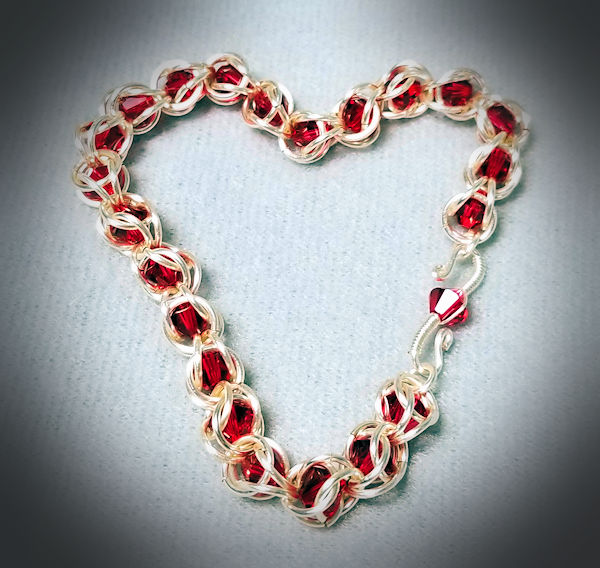
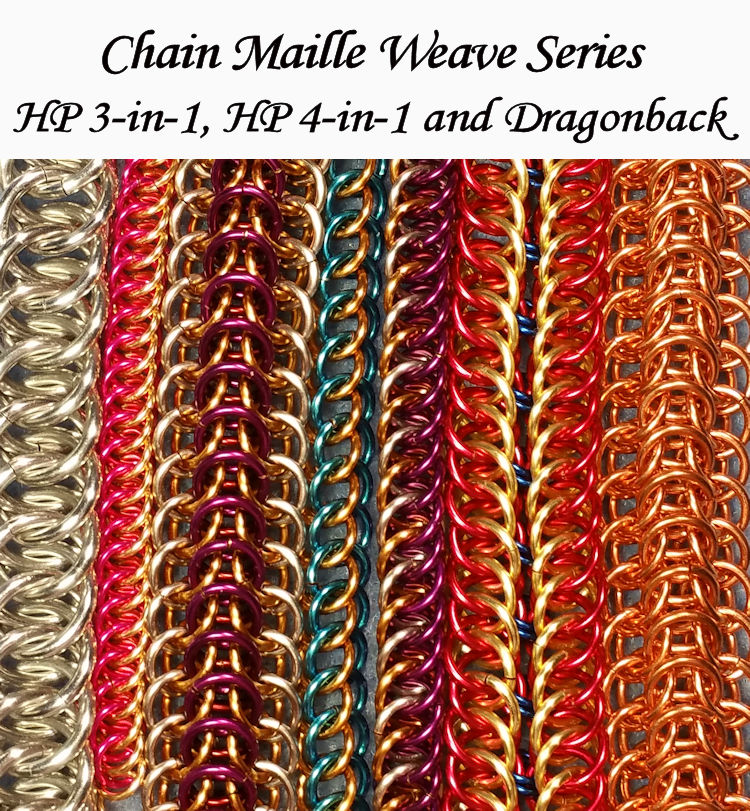
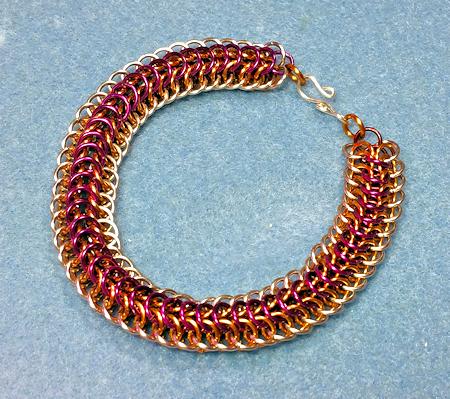


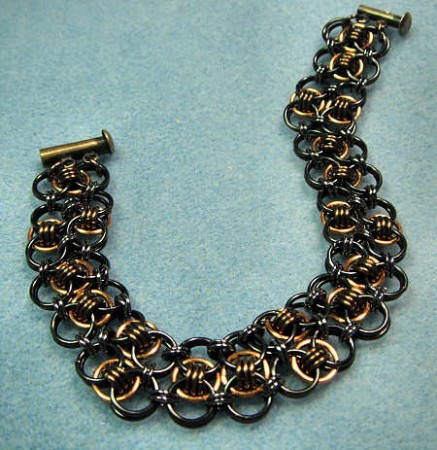 OK, enough about gauges – let’s talk metals. Base metals are basically anything except those designated as precious (and in the chain maille jewelry world, precious means silver, gold, niobium and titanium.)
OK, enough about gauges – let’s talk metals. Base metals are basically anything except those designated as precious (and in the chain maille jewelry world, precious means silver, gold, niobium and titanium.)